
Gilbert and Sullivan refers to the Victorian-era theatrical partnership of the dramatist W. S. Gilbert (1836–1911) and the composer Arthur Sullivan (1842–1900) and to the works they jointly created. The two men collaborated on fourteen comic operas between 1871 and 1896, of which H.M.S. Pinafore, The Pirates of Penzance and The Mikado are among the best known.
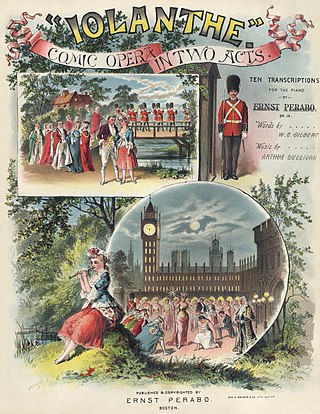
Iolanthe; or, The Peer and the Peri is a comic opera with music by Arthur Sullivan and libretto by W. S. Gilbert, first performed in 1882. It is one of the Savoy operas and is the seventh of fourteen operatic collaborations by Gilbert and Sullivan. In the opera, the fairy Iolanthe has been banished from fairyland because she married a mortal; this is forbidden by fairy law. Her son, Strephon, is an Arcadian shepherd who wants to marry Phyllis, a Ward of Chancery. All the members of the House of Peers also want to marry Phyllis. When Phyllis sees Strephon hugging a young woman, she assumes the worst and sets off a climactic confrontation between the peers and the fairies. The opera satirises many aspects of British government, law and society. The confrontation between the fairies and the peers is a version of one of Gilbert's favourite themes: a tranquil civilisation of women is disrupted by a male-dominated world through the discovery of mortal love.

The Sorcerer is a two-act comic opera, with a libretto by W. S. Gilbert and music by Arthur Sullivan. It was the British duo's third operatic collaboration. The plot of The Sorcerer is based on a Christmas story, An Elixir of Love, that Gilbert wrote for The Graphic magazine in 1876. A young man, Alexis, is obsessed with the idea of love levelling all ranks and social distinctions. To promote his beliefs, he invites the proprietor of J. W. Wells & Co., Family Sorcerers, to brew a love potion. This causes everyone in the village to fall in love with the first person they see and results in the pairing of comically mismatched couples. In the end, Wells must sacrifice his life to break the spell.

Princess Ida; or, Castle Adamant is a comic opera with music by Arthur Sullivan and libretto by W. S. Gilbert. It was their eighth operatic collaboration of fourteen. Princess Ida opened at the Savoy Theatre on 5 January 1884, for a run of 246 performances. The piece concerns a princess who founds a women's university and teaches that women are superior to men and should rule in their stead. The prince to whom she had been married in infancy sneaks into the university, together with two friends, with the aim of collecting his bride. They disguise themselves as women students, but are discovered, and all soon face a literal war between the sexes.
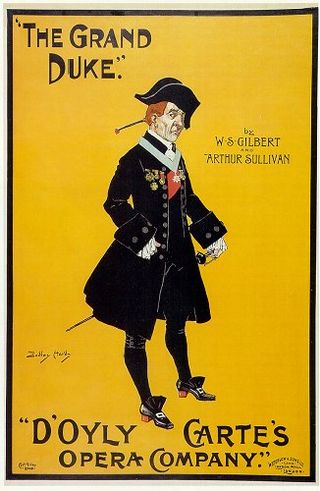
The Grand Duke; or, The Statutory Duel, is the final Savoy Opera written by librettist W. S. Gilbert and composer Arthur Sullivan, their fourteenth and last opera together. It premiered at the Savoy Theatre on 7 March 1896, and ran for 123 performances. Despite a successful opening night, the production had a relatively short run and was the partnership's only financial failure, and the two men never worked together again. In recent decades, the opera has been revived professionally, first in the US and then in the UK.

Edward Askew Sothern was an English actor known for his comic roles in Britain and America, particularly Lord Dundreary in Our American Cousin. He was also known for his many practical jokes.
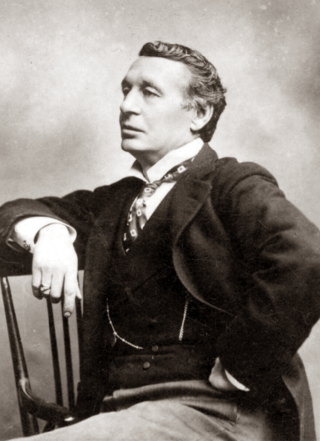
Sir Charles Wyndham, néCharles Culverwell, was an English actor and theatre proprietor. Wyndham's Theatre in London is named after him, and he also built the New Theatre nearby.
Fallen Fairies; or, The Wicked World, is a two-act comic opera, with a libretto by W. S. Gilbert and music by Edward German. The story is an operatic adaptation of Gilbert's 1873 blank-verse fairy comedy, The Wicked World. In Fairyland, the fairies are curious about wicked mortals, especially their strange capacity for love. They summon three mortal men from the world below to observe them and to teach the men how to live virtuously. The fairies fall in love with the mortals, become jealous of each other and behave badly. The men return to Earth, and the fairies realize that love is overrated.

Haste to the Wedding is a three-act comic opera with a libretto by W. S. Gilbert and music by George Grossmith, based on Gilbert's 1873 play, The Wedding March. The opera was the most ambitious piece of composition undertaken by Grossmith.
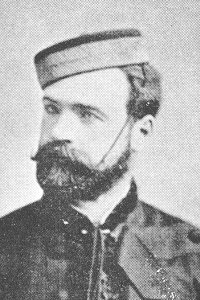
Hugh Talbot, born Hugo Talbot Brennan, was an Irish tenor best known for creating, to universally bad reviews, the role of Frederic in the Gilbert and Sullivan hit The Pirates of Penzance in the original New York production.

No Cards is a "musical piece in one act" for four characters, written by W. S. Gilbert, with music composed and arranged by Thomas German Reed. It was first produced at the Royal Gallery of Illustration, Lower Regent Street, London, under the management of German Reed, opening on 29 March 1869 and closing on 21 November 1869. The work is a domestic farce of mistaken identities and inept disguises, as two men desperately compete to marry a wealthy young lady. One is young and poor, and the other is a rich miser. Each disguises himself as her guardian.
This is a selected list of W. S. Gilbert's works, including all that have their own Wikipedia articles. For a complete list of Gilbert's dramatic works, see List of W. S. Gilbert dramatic works.

Foggerty's Fairy and Other Tales is an 1890 book by W. S. Gilbert, collecting several of the short stories and essays he wrote in his early career as a magazine writer. A number of them were later adapted as plays or opera librettos.

Sir William Schwenck Gilbert was an English dramatist, librettist, poet and illustrator best known for his collaboration with composer Arthur Sullivan, which produced fourteen comic operas. The most famous of these include H.M.S. Pinafore, The Pirates of Penzance and one of the most frequently performed works in the history of musical theatre, The Mikado. The popularity of these works was supported for over a century by year-round performances of them, in Britain and abroad, by the repertory company that Gilbert, Sullivan and their producer Richard D'Oyly Carte founded, the D'Oyly Carte Opera Company. These Savoy operas are still frequently performed in the English-speaking world and beyond.

Dan'l Druce, Blacksmith is a play by W. S. Gilbert, styled "A Three-Act Drama of Puritan times". It opened at the Haymarket Theatre in London on 11 September 1876, starring Hermann Vezin, Johnston Forbes-Robertson and Marion Terry. The play was a success, running for about 100 performances and enjoying tours and several revivals. It was popular enough to be burlesqued in a contemporary work, Dan'l Tra-Duced, Tinker, at the Strand Theatre. In an 1894 revival, Nancy McIntosh played Dorothy.
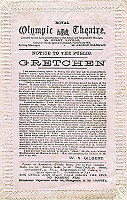
Gretchen is a tragic four-act play, in blank verse, written by W. S. Gilbert in 1878–79 based on Goethe's version of part of the Faust legend.

The Ne'er-do-Weel is a three-act drama written by the English dramatist W. S. Gilbert. It is the second of three plays that he wrote at the request of the actor Edward Sothern. The story concerns Jeffery Rollestone, a gentleman who becomes a vagabond after Maud, the girl he loves, leaves him. He meets Gerard, an old school chum who arranges for him to have a good post. Jeffery returns the favour by sacrificing to try to help Gerard marry Maud, even though Jeffery and Maud still love each other.

May Fortescue was an actress, singer and actor-manager of the Victorian era and a protégée of playwright W. S. Gilbert. She was a member of the D'Oyly Carte Opera Company from 1881 to 1883, when she left the company following her engagement to a nobleman, young Arthur Cairns, Lord Garmoyle. Cairns soon broke off the engagement under pressure from his friends, and Fortescue returned to the stage in leading roles.

Trial by Jury is a comic opera in one act, with music by Arthur Sullivan and libretto by W. S. Gilbert. It was first produced on 25 March 1875, at London's Royalty Theatre, where it initially ran for 131 performances and was considered a hit, receiving critical praise and outrunning its popular companion piece, Jacques Offenbach's La Périchole. The story concerns a "breach of promise of marriage" lawsuit in which the judge and legal system are the objects of lighthearted satire. Gilbert based the libretto of Trial by Jury on an operetta parody that he had written in 1868.
William Blakeley was an English actor.
















